Ray Optics
Question 1. An air bubble in a glass slab with refractive index1.5 (near normal incidence) is 5 cm deep when viewed from one surface and 3 deep when viewed from the opposite face. The thickness of the slab is
- 8 cm
- 10 cm
- 12 cm
- 16 cm
Answer: 3. 12 cm
Refractive index = \(\mu=\frac{\text { real depth }}{\text { apparent depth }}\)
In the first case, \(\mu=\frac{x}{5 \mathrm{~cm}}\),
and in the second case, \(\mu=\frac{D-x}{3 \mathrm{~cm}}\)
∴ x+(D-x) = μ(5 cm + 3 cm)
⇒ D = μ(8 cm) =1.5(8 cm) =12 cm
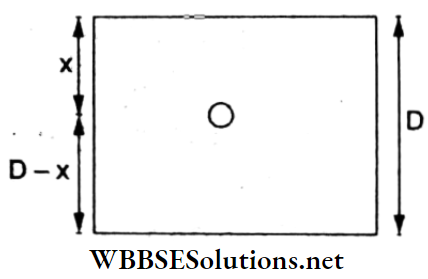
Question 2. A ray of light traveling in a transparent medium of refractive index μ. falls on a surface separating the medium from the air at an angle of incidence of 45°. For which of the following values of p can the ray undergo total internal reflection?
- μ =1.33
- μ =1.50
- μ =1.25
- μ =1.40
Answer: 2. μ = 1.50
For total internal reflection, the angle of incidence (i) must be greater than the critical angle (θC).
But, \(\mu=\frac{1}{\sin \theta_c} \Rightarrow \sin \theta_c=\frac{1}{\mu}\)
⇒ \(\sin i>\sin \theta_c \Rightarrow \sin 45^{\circ}>\frac{1}{\mu}\)
∴ \(\frac{1}{\sqrt{2}}>\frac{1}{\mu} \Rightarrow \mu>1.4\)
Hence, μ =1.50.
Question 3. A small coin is resting on the bottom of a beaker filled with a transparent liquid. A ray of light from the coin travels up to the 4 cm surface of the liquid and moves along the surface. How fast is the light traveling in the liquid?
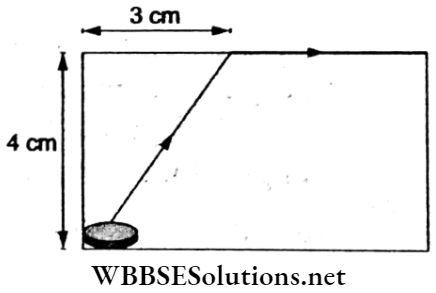
- 1.8 x 108 m s-1
- 2.4 x 108 m s-1
- 3.0 x 108 m s-1
- 1.2 x 108 m s-1
Answer: 1. 1.8 x 108 m s-1
In the given situation, Medical the angle Entrance of incidence Physics is the critical angle θC, for which \(\theta_c=\frac{3 \mathrm{~cm}}{5 \mathrm{~cm}}=\frac{3}{5}\)
The refractive index is
⇒ \(\mu=\frac{1}{\sin \theta_c}=\frac{5}{3}\)
In terms of the speed of light,
⇒ \(\mu=\frac{c_0}{c_1}\)
The speed of light in the liquid is
∴ \(c_1=\frac{c_0}{\mu}=\frac{3 \times 10^8 \mathrm{~m} \mathrm{~s}^{-1}}{5 / 3}=\frac{9}{5} \times 10^8 \mathrm{~m} \mathrm{~s}^{-1}=1.8 \times 10^8 \mathrm{~m} \mathrm{~s}^{-1}\).
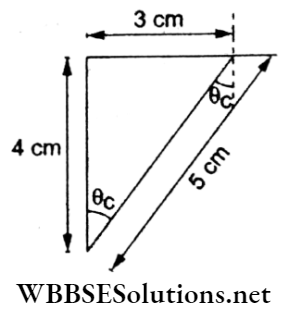
Question 4. For the given incident ray as shown in the figure, the condition for the total internal reflection of the ray will be satisfied if the refractive index of the block is
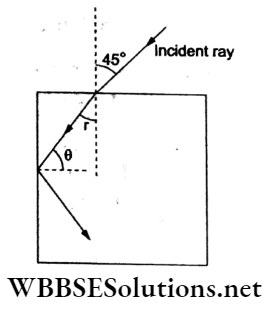
- \(\frac{\sqrt{3}+1}{2}\)
- \(\frac{\sqrt{2}+1}{2}\)
- \(\sqrt{\frac{3}{2}}\)
- \(\sqrt{\frac{7}{6}}\)
Answer: 3. \(\sqrt{\frac{3}{2}}\)
The refractive index of the block is
⇒ \(\mu=\frac{\sin 45^{\circ}}{\sin r}=\frac{1 / \sqrt{2}}{\sin \left(90^{\circ}-\theta\right)}=\frac{1}{\sqrt{2} \cos \theta}\)
⇒ \(\mu^2=\frac{1}{2 \cos ^2 \theta}=\frac{1}{2\left(1-\sin ^2 \theta\right)}\)
⇒\(\sin ^2 \theta=1-\frac{1}{2 \mu^2}\) (1)
For total internal reflection, θ > θC
⇒ \(\sin ^2 \theta>\sin ^2 \theta_c\left(=\frac{1}{\mu^2}\right)\) (2)
Comparing (1) and (2),
⇒ \(1-\frac{1}{2 \mu^2}>\frac{1}{\mu^2} \Rightarrow \frac{3}{2 \mu^2}<1\)
∴ \(\frac{2 \mu^2}{3}>1 \text {, hence } \mu \geq \sqrt{\frac{3}{2}}\).
Question 5. Light enters at an angle of incidence in a transparent rod of refractive index μ. For what value of the refractive index of the material of the rod will the light once entered into it not leave it through its lateral face whatever be the value of the angle of incidence?
- μ = l
- μ = 1.4
- μ > √2
- μ = 1.3
Answer: 3. μ > √2
For refraction at P, from Snell’s law,
⇒ \(\mu=\frac{\sin i}{\sin r}=\frac{\sin i}{\sin \left(90^{\circ}-\theta\right)}=\frac{\sin i}{\cos \theta}\) (1)
For total internal reflection at Q, the angle of incidence (i) must be greater than the critical angle \(\theta_c\left[=\sin ^{-1}\left(\frac{1}{\mu}\right)\right]\)
From (1),
⇒ \(\cos \theta=\frac{\sin i}{\mu}\)
⇒ \(1-\sin ^2 \theta=\frac{\sin ^2 i}{\mu^2}\)
⇒ \(\sin ^2 \theta=1-\frac{\sin ^2 i}{\mu^2}\) → (2)
But \(\sin \theta>\sin \theta_c \Rightarrow \sin ^2 \theta>\frac{1}{\mu^2}\) → (3)
From (2) and (3),
⇒ \(\frac{1}{\mu^2}<1-\frac{\sin ^2 i}{\mu^2}\)
⇒ \(1<\mu^2-\sin ^2 i\)
⇒ \(1+\sin ^2 i<\mu^2\)
∴ \(\mu^2>1+\sin ^2 i\)
The maximum value of sin i is 1, so
μ2 > 2 or μ > √2.
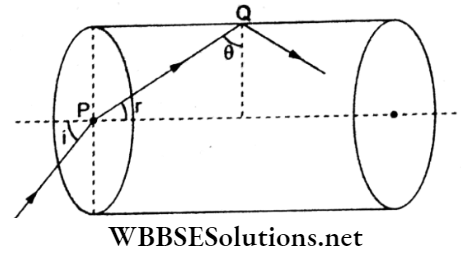
Question 6. One face of a 6-cm-thick rectangular glass plate is silvered. An object held at 8 cm in front of the first face forms an image 12 cm behind the silvered face. The refractive index of the glass is
- 1.2
- 1.6
- 1.8
- 1.4
Answer: 1. 1.2
Let AB be the true position of the plane mirror and A’B’ be its displaced apparent position due to refraction.
For a plane mirror, the object and image are at an equal distance from the mirror, so
8 cm + x = (6 cm – x) +12 cm
x = 5 cm
Now, the refractive index of glass is
∴ \(\mu=\frac{\text { real depth }}{\text { apparent depth }}=\frac{6 \mathrm{~cm}}{5 \mathrm{~cm}}=1.2\).
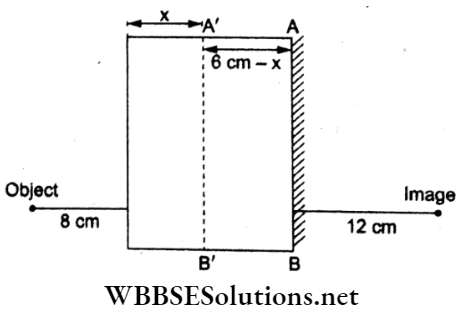
Question 7. The apparent depth of water in a cylindrical water tank of diameter 2R cm is reduced at the rate of x cm min-1 when water is being drained out at a constant rate. The amount of water drained in cm3 min-1 is (n1 = refractive index of air, n2 = refractive index of water)
- \(\frac{x \pi R^2 n_1}{n_2}\)
- \(\frac{x \pi R^2 n_2}{n_1}\)
- \(\frac{2 \pi R x n_1}{n_2}\)
- \(\frac{2 \pi R x n_2}{n_1}\)
Answer: 2. \(\frac{x \pi R^2 n_2}{n_1}\)
The refractive index of water is
⇒ \(\frac{n_2}{n_1}=\frac{\text { real depth }}{\text { apparent depth }}\)
⇒ \(\frac{n_2}{n_1}=\frac{H}{h} \Rightarrow \frac{d h}{d t}=\frac{n_1}{n_2} \frac{d H}{d t}\)
Given, \(\frac{d h}{d t}=x \mathrm{~cm} \mathrm{~min}^{-1}, \text { so } \frac{d H}{d t}=\frac{n_2}{n_1} x \mathrm{~cm} \mathrm{~min}^{-1}\)
∴ Volume drained out per min = \(A\left(\frac{d H}{d t}\right)=\pi R^2 \frac{n_2}{n_1} x\).
Question 8. Light waves enter from medium 1 to medium 2. Its velocity in medium 2 is double that in medium 1. For total internal reflection, the angle of incidence must be greater than
- 90°
- 40°
- 30°
- 60°
Answer: 3. 30°
The refractive index of medium 1 is greater than that of medium 2 since the speed in medium 2 is greater than that in 1.
Now, \({ }^2 n_1=\frac{n_1}{n_3}=\frac{c_0 / c_1}{c_0 / c_3}=\frac{c_2}{c_1}=\frac{2 c_1}{c_1}=2\)
If θC is the critical angle,
⇒ \(\theta_c=\frac{1}{2 n_1}=\frac{1}{2}=\sin 30^{\circ}\)
θC = 30°.
Question 9. Which of the following is not due to total internal reflection?
- Working with optical fiber
- Mirage on hot summer days
- Difference between the real and apparent depth of a pond
- Brilliance of diamond
Answer: 3. Difference between the real and apparent depth of a pond
Workings of optical fiber, formation of mirages, and brilliance of diamond can be explained on the basis of total internal reflection.
Question 10. In the given figure, the apparent depth of the liquid column is
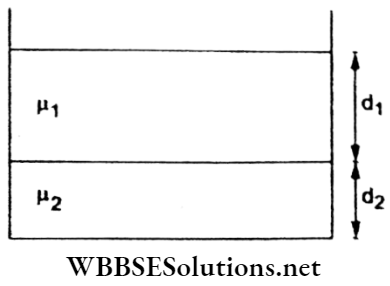
- \(\frac{d_1}{\mu_2}+\frac{d_2}{\mu_1}\)
- \(\sqrt{\frac{d_1 d_2}{\mu_1 \mu_2}}\)
- \(\frac{d_1}{\mu_1}+\frac{d_2}{\mu_2}\)
- \(\frac{d_1+d_2}{\mu_1+\mu_2}\)
Answer: 3. \(\frac{d_1}{\mu_1}+\frac{d_2}{\mu_2}\)
Apparent shift of the bottom in the lower medium is x2 = \(d_2\left(1-\frac{1}{\mu_2}\right)\)
and in the upper medium is x1 = \(d_1\left(1-\frac{1}{\mu_1}\right)\)
Total shift is x1 + x2 = \(\left(d_1+d_2\right)-\left(\frac{d_1}{\mu_1}+\frac{d_2}{\mu_2}\right)\)
Apparent depth = total depth- shift
∴ \(\left(d_1+d_2\right)-\left(x_1+x_2\right)=\frac{d_1}{\mu_1}+\frac{d_2}{\mu_2}\).
Question 11. Considering the normal incidence of the ray, the equivalent refractive index of the combination of two slabs shown in the figure is
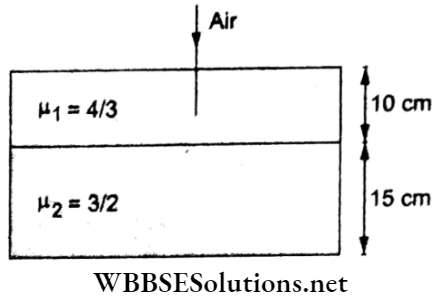
- 1.8
- 1.43
- 2
- None of these
Answer: 2. 1.43
The apparent depth for the given pair of media is
⇒ \(d=\frac{d_1}{\mu_1}+\frac{d_2}{\mu_2}\)
For equivalent refractive index,
⇒ \(\mu=\frac{\text { real depth }}{\text { apparent depth }}=\frac{d_1+d_2}{\frac{d_1}{\mu_1}+\frac{d_2}{\mu_2}}\)
Given, \(\mu_1=\frac{4}{3}, d_1=10 \mathrm{~cm}, \mu_2=\frac{3}{2}, d_2=15 \mathrm{~cm}\)
∴ \(\mu=\frac{10 \mathrm{~cm}+15 \mathrm{~cm}}{(10 \mathrm{~cm}) \frac{3}{4}+(15 \mathrm{~cm}) \frac{2}{3}}=\frac{25}{17.5}=1.43\)
Question 12. A microscope is focused on a mark on a piece of paper and a slab of glass of thickness 3 cm and refractive index 1.5 is placed over the mark. How should the microscope be moved to get the mark in focus again?
- 2 cm upward
- 1 cm upward
- 4.5 cm downward
- 1 cm downward
Answer: 2. 1 cm upward
In the given figure, O is the position of the mark and I is its apparent position.
Refractive index, \(\mu=\frac{\mathrm{AO}}{\mathrm{AI}}\)
∴ \(1.5=\frac{3 \mathrm{~cm}}{\mathrm{AI}} \Rightarrow \mathrm{AI}=2 \mathrm{~cm}\)
Shift of the image
= OI = 3 cm- 2 cm =1 cm.
The microscope must be raised upward from P to Q by 1 cm.
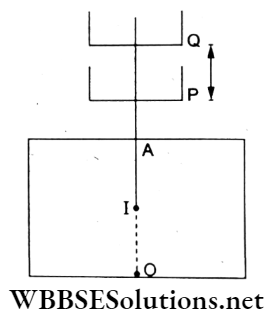
Question 13. For the situation shown in the figure, what should be the refractive index of glass so that the ray will suffer total internal reflection at the vertical face?
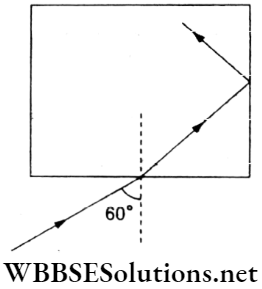
- 1.732
- 1.5
- 1.32
- 1.6
Answer: 3. 1.32
Refractive index,
⇒ \(\mu=\frac{\sin 60^{\circ}}{\sin r}=\frac{\sin 60^{\circ}}{\sin \left(90^{\circ}-\theta\right)}=\frac{\sqrt{3}}{2 \cos \theta}\)
For total internal reflection,
θ ≥ θC,
⇒ \(\cos \theta_c=\frac{\sqrt{3}}{2 \mu}=\frac{\sqrt{3}}{2\left(1 / \sin \theta_c\right)}\)
⇒ \(\tan \theta_c=\frac{2}{\sqrt{3}}\)
Hence, μ = \({cosec} \theta_c=\frac{\sqrt{7}}{2}=1.32\)
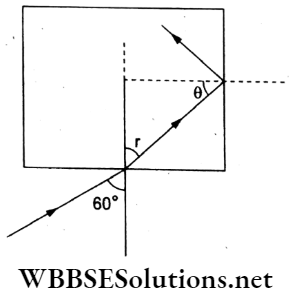
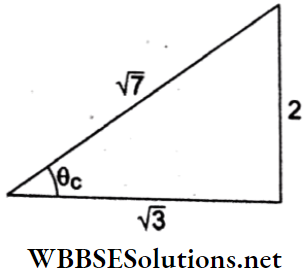
Question 14. In a concave mirror, an object is placed at a distance d1 from the focus and the image is formed at a distance d2 from the focus. The focal length of the mirror is
- \(\sqrt{d_1 d_2}\)
- \(d_1 d_2\)
- \(\frac{d_1+d_2}{2}\)
- \(\sqrt{\frac{d_1}{d_2}}\)
Answer: 1. \(\sqrt{d_1 d_2}\)
From the mirror formula, \(\frac{1}{f}=\frac{1}{u}+\frac{1}{v}\)
Given, u = d1 + f, v = d2 + f
⇒ \(\frac{1}{f}=\frac{1}{d_1+f}+\frac{1}{d_2+f}=\frac{\left(d_1+d_2\right)+2 f}{\left(d_1+f\right)\left(d_2+f\right)}\)
⇒ d1d2 + f(d1+f2)+f2 = (d1+d2)f +2f2
∴ \(f^2=d_1 d_2 \Rightarrow f=\sqrt{d_1 d_2}\).
Question 15. A short linear object of length L lies along the axis of a concave mirror of focal length f at a distance d from the pole of the mirror. The size of the image is then (nearly)
- \(\frac{L f}{d-f}\)
- \(\frac{d-f}{L f}\)
- \(\frac{L f^2}{(d-f)^2}\)
- \(\frac{L(d-f)^2}{f^2}\)
Answer: 3. \(\frac{L f^2}{(d-f)^2}\)
Since \(\frac{1}{u}+\frac{1}{v}=\frac{1}{f}\)
Differentiating, \(\frac{\Delta u}{u^2}+\frac{\Delta v}{v^2}=0\)
Size of the object placed along the axis is L = AM, SO size of the image = \(|\Delta v|=\frac{v^2}{u^2} \cdot L\)
Now, \(1+\frac{u}{v}=\frac{u}{f} \Rightarrow \frac{u}{v}=\frac{u}{f}-1=\frac{u-f}{f}=\frac{d-f}{f}\)
∴ \(|\Delta v|=L\left(\frac{v}{u}\right)^2=\frac{L f^2}{(d-f)^2}\)
Question 16. A 2.0 cm-tall object is placed 15 cm in front of a concave mirror of a focal length of 10 cm. What is the size and nature of the image?
- 4 cm, real
- 4 cm, virtual
- 1 cm, real
- None of these
Answer: 1. 4 cm, real
Given,f =10 cm and M =15 cm. Since u >f, the image will be real and magnified.
∵ \(\frac{1}{u}+\frac{1}{v}=\frac{1}{f} \Rightarrow \frac{1}{15 \mathrm{~cm}}+\frac{1}{v}=\frac{1}{10 \mathrm{~cm}} \Rightarrow \frac{1}{v}=\frac{5}{150 \mathrm{~cm}}\)
⇒ v = 30 cm.
∴ magnification is m = \(\frac{v}{u}=\frac{30 \mathrm{~cm}}{15 \mathrm{~cm}}=2\)
∴ Size of the image = 2 x 2 cm = 4 cm.
Question 17. A concave mirror of focal length f1 is placed at a distance d from a convex lens of focal length f2. A beam of light coming from infinity and incident on this convex lens-concave mirror combination returns to infinity. The distance d must be equal to
- f1+f2
- -f1+f2
- 2f1+f2
- -2f1+f2
Answer: 3. 2f1+f2
Parallel rays from infinity incident on the convex lens L get focused at its focus F, where OF = f2. Since the rays retrace their paths after reflection from the concave mirror, the rays must be incident normally (coming from its center) and therefore F must be the center of curvature of the concave mirror. So, PF = R = 2f1
The distance between the lens and the mirror is
d = OF + FP = f2 + 2f1.
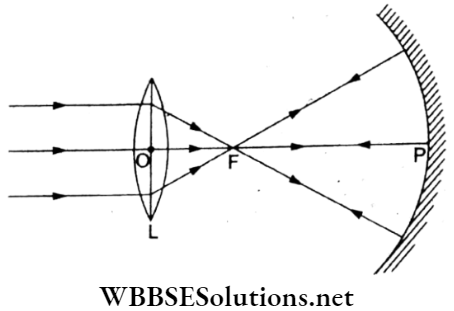
Question 18. The angle of incidence for a ray of light at a refracting surface of a prism is 45°. The angle of the prism is 60°. If the ray suffers a minimum deviation through the prism, the angle of minimum deviation and the refractive index of the material of the prism respectively are
- \(30^{\circ}, \sqrt{2}\)
- \(45^{\circ}, \sqrt{2}\)
- \(45^{\circ}, \frac{1}{\sqrt{2}}\)
- \(30^{\circ}, \frac{1}{\sqrt{2}}\)
Answer: 1. [late]30^{\circ}, \sqrt{2}[/latex]
Given, A = 60° and i = 45°.
Since the ray suffers minimum deviation, i = i’ and r = r’ with r + r’ = A.
Hence, r + r’ = r+r = A = 60° ⇒ r = 30°.
Again, i+i’ = A+8 ⇒ i+i=A+δm.
the angle of minimum deviation,
δm = 2i-A = 2(45°)- 60° = 30°.
Refractive index,
∴ \(\mu=\frac{\sin i}{\sin r}=\frac{\sin 45^{\circ}}{\sin 30^{\circ}}=\sqrt{2}\).
Question 19. The refracting angle of a prism is A and the refractive index of the material of the prism is cot (A/2). The angle of minimum deviation is
- 180°- 3A
- 180°- 2A
- 90°- A
- 180° + 2A
Answer: 2. 180°- 2A
For a prism,
⇒ \(\mu=\frac{\sin \frac{A+\delta_m}{2}}{\sin \frac{A}{2}}=\cot \frac{A}{2} \text { (given) }\)
⇒ \(\cos \frac{A}{2}=\sin \left(90^{\circ}-\frac{A}{2}\right)=\sin \left(\frac{A+\delta_m}{2}\right)\)
Hence, \(\frac{A+\delta_m}{2}=\frac{\pi}{2}-\frac{A}{2}\).
So, the angle of minimum deviation, δm = π – 2A = 180°- 2A
Question 20. A ray of light is incident at an angle of incidence i on one face of a prism of angle A (assumed to be small) and emerges normally from the opposite face. If the refractive index of the material of the prism is μ, the angle of incidence is nearly equal to
- μA
- \(\frac{\mu A}{2}\)
- \(\frac{A}{\mu}\)
- \(\frac{A}{2 \mu}\)
Answer: 1. μA
Since the ray emerges normally out of the prism, angle r = A.
⇒ \(\mu=\frac{\sin i}{\sin r}=\frac{i}{r}=\frac{i}{A}\) (for small angles).
Hence, the angle of incidence is i = μA
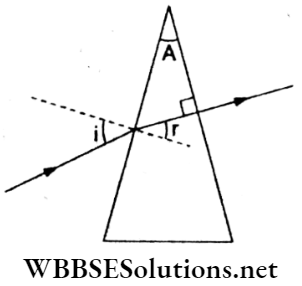
Question 21. The refractive index of the material of a prism is √2 and its refracting angle is 30°. One of the refracting surfaces of the prism is silvered outward. A beam of monochromatic light entering the prism from the other face retraces its path after reflection from the silvered surface. The angle of incidence on the prism is
- 45°
- 60°
- 30°
- 0°
Answer: 1. 45°
Given, μ ⇒ √2 and A = 30°.
Since the ray retraces its path after reflection from the second face, it must be normally incident. So, r = A = 30°.
Now, \(\mu=\frac{\sin i}{\sin r} \Rightarrow \sqrt{2}=\frac{\sin i}{\sin 30^{\circ}}\)
⇒ \(\sin i=\sqrt{2} \times \frac{1}{2}=\frac{1}{\sqrt{2}}=\sin 45^{\circ}\)
∴ i = 45°.
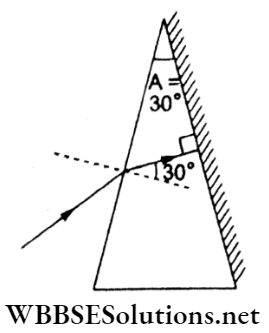
Question 22. If the refractive index of the material of an equilateral prism is √3 then the angle of minimum deviation from the prism is
- 30°
- 45°
- 60°
- 75°
Answer: 3. 60°
Given, A = 60° and μ = √3.
⇒ \(\mu=\frac{\sin \left(\frac{A+\delta_m}{2}\right)}{\sin \left(\frac{A}{2}\right)}\)
⇒ \(\sqrt{3}=2 \sin \left(\frac{60^{\circ}+\delta_m}{2}\right)\)
⇒ \(\sin \left(\frac{60^{\circ}+\delta_m}{2}\right)=\frac{\sqrt{3}}{2}=\sin 60^{\circ}\).
∴ The angle of minimum deviation = δm = 60°.
Question 23. The angle of deviation δ through a dun prism (A small) whose material has its refractive index μ can be expressed by
- \(\delta=(\mu-1) A\)
- \(\delta=(\mu+1) A\)
- \(\delta=\frac{\sin \frac{A+\delta}{2}}{\sin \frac{A}{2}}\)
- \(\delta=\left(\frac{\mu-1}{\mu+1}\right) A\)
Answer: 1. \(\delta=(\mu-1) A\)
For a thin-angled prism, A = small.
So i, i, i’, r, r’ must be small for a ray to emerge.
⇒ \(\mu=\frac{\sin i}{\sin r} \approx \frac{i}{r} \Rightarrow i=\mu r\)
Similarly, i’ = μr’.
Adding, i+i’ = μ{r + r’)
⇒ A + δ = μA ⇒ δ = (μ.-1)A.
Question 24. One face of a prism of refracting angle A is silvered. Light rays incident at an angle of incidence 2A on the first surface retrace their path after suffering reflection at the silvered surface. The refractive index of the die material of the prism is
- 2 sinA
- 2 cosA
- \(\frac{1}{2} \cos A\)
- tan A
Answer: 2. 2 cosA
Since the ray is reflected from the second face, it must be incident normally. Hence, the angle of refraction r-A. Refractive index is
⇒ \(\mu=\frac{\sin i}{\sin r}=\frac{\sin 2 A}{\sin A}=\frac{2 \sin A \cos A}{\sin A}\)
μ = 2cos A
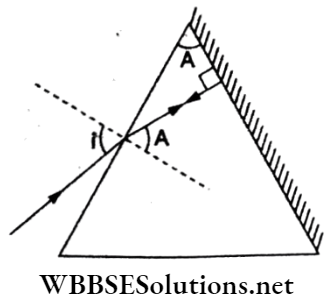
Question 25. The angle of minimum deviation for a glass prism is equal to its refracting angle. The refractive index of glass is 1.5. Then, the angle of the prism is
- \(2 \cos ^{-1}\left(\frac{3}{4}\right)\)
- \(\sin ^{-1}\left(\frac{3}{4}\right)\)
- \(2 \sin ^{-1}\left(\frac{3}{2}\right)\)
- \(\cos ^{-1}\left(\frac{3}{2}\right)\)
Answer: 1. \(2 \cos ^{-1}\left(\frac{3}{4}\right)\)
Given, the angle of prism = A = δm, refractive index = μ =1.5.
From the prism formula,
⇒ \(\mu=\frac{\sin \left(\frac{A+\delta_{\mathrm{m}}}{2}\right)}{\sin \frac{A}{2}}=\frac{\sin \left(\frac{A+A}{2}\right)}{\sin \frac{A}{2}}=\frac{\sin A}{\sin \frac{A}{2}}\)
⇒ \(\mu=\frac{2 \sin \frac{A}{2} \cos \frac{A}{2}}{\sin \frac{A}{2}} \Rightarrow \cos \frac{A}{2}=\frac{\mu}{2}=\frac{3}{4}\)
∴ \(\frac{A}{2}=\cos ^{-1}\left(\frac{3}{4}\right) \Rightarrow A=2 \cos ^{-1}\left(\frac{3}{4}\right)\).
Question 26. For the angle of minimum deviation through a prism to be equal to its refracting angle, the prism must be made of a material whose refractive index
- Lies between √2 and 1
- Lies between 2 and √2
- Is less than 1
- Is greater than 2
Answer: 2. Lies between 2 and √2
Given, δm = A
Hence, \(\frac{\sin \left(\frac{A+\delta_m}{2}\right)}{\sin \left(\frac{A}{2}\right)}=\frac{\sin A}{\sin \frac{A}{2}}=2 \cos \frac{A}{2}\)
Since i + i’ = A+8,
hence at minimum deviation,
i + i = 2A ⇒ i = A
Let us consider the limiting values of i:
⇒ For \(i_{\min }=0, A_{\min }=0 \Rightarrow \mu_{\max }=\left(2 \cos \frac{A}{2}\right)=2 \cos 0=2\)
⇒ Again, \(i_{\max }=90^{\circ}, A_{\max }=90^{\circ}, \text { so } \mu_{\min }=2 \times \cos \frac{90^{\circ}}{2}=\sqrt{2}\)
∴ μ lies between 2 and √2
Question 27. A ray of light is incident on a 60° prism at the minimum deviation position. The angle of refraction at the first face of the prism is
- Zero
- 30°
- 45°
- 60°
Answer: 2. 30°
For a prism, r+r’ = A.
For minimum deviation, r = r’.
r + r = A = 60° ⇒ r = 30°.
Question 28. A thin prism having a refracting angle of 10° is made of crown glass with a refractive index of 1.42. This prism is combined with another thin prism of flint glass with a refractive index 1.7. This combination produces dispersion without deviation. The refracting angle of the second prism should be
- 6°
- 8°
- 10°
- 4°
Answer: 1. 6°
For a crown prism, AC =10° and μC =1.42.
For the flint prism, μF =1.7.
For null deviation, δC + δF = 0
⇒ \(\left(\mu_C-1\right) A_C+\left(\mu_F-1\right) A_F=0\)
∴ \(\left|A_F\right|=\frac{\left(\mu_C-1\right) A_C}{\left(\mu_F-1\right)}=\frac{(1.42-1) 10^{\circ}}{(1.7-1)}=\frac{0.42}{0.70} \times 10^{\circ}=6^{\circ}\).
Question 29. A plano-convex lens fits exactly into a plano-concave lens. Their plane surfaces are parallel to each other. If fine lenses are made of different materials of refractive indices μ1 and μ2, and R is the radius of curvature of the curved surface of the lenses then the focal length of the combination is
- \(\frac{R}{2\left(\mu_1+\mu_2\right)}\)
- \(\frac{R}{2\left(\mu_1-\mu_2\right)}\)
- \(\frac{R}{\left(\mu_1-\mu_2\right)}\)
- \(\frac{2 R}{\left(\mu_2-\mu_1\right)}\)
Answer: 3. \(\frac{R}{\left(\mu_1-\mu_2\right)}\)
For a convex lens,
⇒ \(\frac{1}{f_1}=\left(\mu_1-1\right)\left(\frac{1}{R_1}-\frac{1}{R_2}\right)\)
⇒ \(\left(\mu_1-1\right)\left(\frac{1}{\infty}-\frac{1}{-R}\right)=\frac{\left(\mu_1-1\right)}{R}\)
For a concave lens,
⇒ \(\frac{1}{f_2}=\left(\mu_2-1\right)\left(\frac{1}{R_1}-\frac{1}{R_2}\right)=\left(\mu_2-1\right)\left(-\frac{1}{R}-\frac{1}{\infty}\right)=-\frac{\left(\mu_2-1\right)}{R}\)
For the combination with equivalent focal length F
⇒ \(\frac{1}{F}=\frac{1}{f_1}+\frac{1}{f_2}=\frac{\left(\mu_1-1\right)-\left(\mu_2-1\right)}{R}=\frac{\mu_1-\mu_2}{R}\)
∴ \(F=\frac{R}{\left(\mu_1-\mu_2\right)}\)
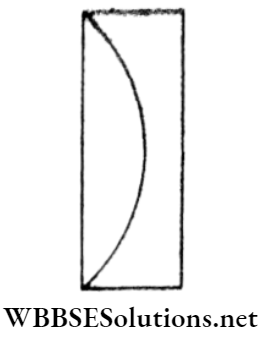
Question 30. A biconvex lens of glass (μ =15) has a radius of curvature of 20 cm. Which one of the following options describes best the image formed of a dying object of height 2 cm placed 30 cm from the lens?
- Virtual, erect, height = 0.5 cm
- Real, inverted, height = 4 cm
- Real, inverted, height =1 cm
- Virtual, erect, height =1 cm
Answer: 2. Real, inverted, height = 4 cm
Given, a convex lens,
μ =1.5, R1 = R2 = 20 cm, h0, = 2 cm, u = 30 cm.
From the lens formula,
⇒ \(\frac{1}{f}=(\mu-1)\left(\frac{1}{R_1}-\frac{1}{R_2}\right)=(1.5-1)\left(\frac{1}{20 \mathrm{~cm}}-\frac{1}{-20 \mathrm{~cm}}\right)\)
⇒ \(0.5\left(\frac{2}{20 \mathrm{~cm}}\right)=\frac{1}{20 \mathrm{~cm}}\)
Again \(\frac{1}{f}=\frac{1}{v}-\frac{1}{u}\)
⇒ \(\frac{1}{20 \mathrm{~cm}}=\frac{1}{v}-\frac{1}{(-30 \mathrm{~cm})} \Rightarrow \frac{1}{v}=\frac{1}{60 \mathrm{~cm}}\)
⇒ v = 60 cm.
Magnification = \(m=\frac{v}{u}=\frac{60 \mathrm{~cm}}{-30 \mathrm{~cm}}=-2\)
Negative magnification means the image is real, inverted and whose height is
⇒ \(h_{\mathrm{I}}=|m| h_0=2 \times 2 \mathrm{~cm}=4 \mathrm{~cm}\)
Question 31. A lens having focal length f and an aperture of diameter D forms an image of intensity I. An aperture of diameter D/2 in the central region of the lens is covered by black paper. The focal length of the lens and intensity of the image now will be respectively
- \(f \text { and } \frac{I}{4}\)
- \(\frac{3 f}{4} \text { and } \frac{I}{2}\)
- \(f \text { and } \frac{3 I}{4}\)
- \(\frac{f}{2} \text { and } \frac{I}{2}\)
Answer: 3. \(f \text { and } \frac{3 I}{4}\)
The focal length of a lens does not depend on the area exposed to the incoming incident rays, so the focal length remains unchanged at f.
The intensity of the image formed is proportional to the area exposed.
Thus, \(\frac{I_2}{I_1}=\frac{A_2}{A_1}=\frac{\pi\left(\frac{D}{2}\right)^2-\pi\left(\frac{D}{4}\right)^2}{\pi\left(\frac{D}{2}\right)^2}=\frac{3}{4}\)
∴ \(I_2=\frac{3}{4} I_1=\frac{3}{4} I\)
Question 32. A biconvex lens is cut into two halves along
- XOX’ and
- YOY’ as shown in the figure. Let f,f’,f” be the focal lengths of the complete lens, of each half in case (1) and of each half in case (2) respectively.
Choose the correct statement from the following.
![]()
- f’ = f, f” = f
- f’ = 2f, f” = 2f
- f’ = f, f” = 2f
- f’ = 2f, f” = f
Answer: 3. f’ = f, f” = 2f
For the complete lens,
⇒ \(\frac{1}{f}=(\mu-1)\left(\frac{1}{R}-\frac{1}{-R}\right)=\frac{2(\mu-1)}{R}\)
The focal length of each half-cut lens along X’OX will be
⇒ \(\frac{1}{f^{\prime}}=(\mu-1) \frac{2}{R}, \text { hence } f^{\prime}=f\)
The focal length of each half-cut lens along YOY’ is
⇒ \(\frac{1}{f^{\prime \prime}}=(\mu-1)\left(\frac{1}{R}-\frac{1}{\infty}\right)=\frac{\mu-1}{R}=\frac{1}{2}\left[\frac{2(\mu-1)}{R}\right]=\frac{1}{2 f} \Rightarrow f^{\prime \prime}=2 f\)
∴ \(f^{\prime \prime}=2 f \text { and } f^{\prime}=f\)
Question 33. An object is located on a wall. An image of the same size is to be obtained on the parallel wall with the help of a convex lens. The lens is placed at a distance d ahead of the second wall. The required focal length of the lens should be
- \(\text { only } \frac{d}{4}\)
- \(\text { only } \frac{d}{2}\)
- \(\text { more than } \frac{d}{4} \text { but less than } \frac{d}{2}\)
- \(\text { less than } \frac{d}{4}\)
Answer: 2. \(\text { only } \frac{d}{2}\)
Since the object and its image are of the same size, magnification is
⇒ \(m=\frac{|v|}{|u|}=1\)
Since v = d,
u = v = d.
From the lens formula,
⇒ \(\frac{1}{f}=\frac{1}{v}-\frac{1}{u}=\frac{1}{d}-\frac{1}{(-d)}=\frac{2}{d}\)
⇒ \(f=\frac{d}{2}\)
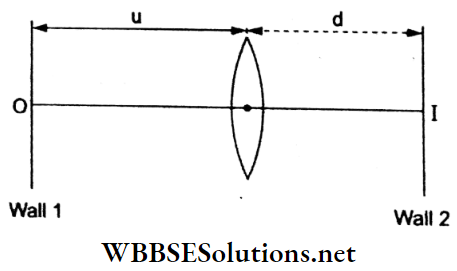
Question 34. A plano-convex lens is made of a material of refractive index μ, =1.5. The radius of curvature of the curved surface of the lens is 20 cm. If its plane surface is silvered, the focal length of the silvered lens will be
- 10 cm
- 20 cm
- 40 cm
- 60cm
Answer: 2. 20 cm
When the plane surface is not silvered, its focal length is f1 where
⇒ \(\frac{1}{f_1}=(\mu-1)\left(\frac{1}{R_1}-\frac{1}{R_2}\right)=(1.5-1)\left(\frac{1}{R}-\frac{1}{\infty}\right)=\frac{1}{2 R}\)
f1 = 2R = 2(20 cm) = 40 cm.
When the plane surface is silvered, rays from focus F will be parallel after refraction, fall normally on the silvered face, and retrace its path, forming the real image at F.
Thus, the silvered lens acts as a concave mirror with a center at F whose radius of curvature = f1 = 4O cm.
⇒ \(f \text { of mirror }=\frac{40 \mathrm{~cm}}{2}=20 \mathrm{~cm}\).
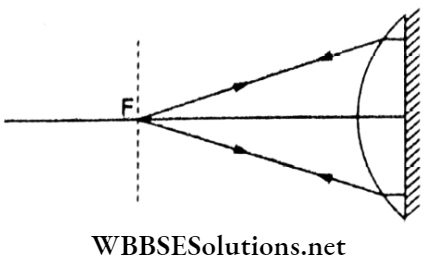
Alternative method
In the silvered lens, there are two refractions from the curved surface and one reflection from the plane surface.
Hence, the power of the silvered lens
= power of the lens + power of the mirror
⇒ \(\frac{1}{F}=\frac{2}{f_l}+\frac{1}{f_{\mathrm{m}}}=\frac{2}{40 \mathrm{~cm}}+\frac{1}{\infty}\)
F = 20 cm.
Question 35. A plano-convex lens is made of a material with a refractive index of 1.6. The radius of curvature of the curved surface is 60 cm. The focal length of the lens is
- 50 cm
- 100 cm
- 200 cm
- 400 cm
Answer: 2. 100 cm
Given, μ =1.6, R1 = 60 cm, and R2 = ∞ (for plane surface).
From the lens maker’s formula,
⇒ \(\frac{1}{f}=(\mu-1)\left(\frac{1}{R_1}-\frac{1}{R_2}\right)\)
∴ \((1.6-1)\left(\frac{1}{60 \mathrm{~cm}}-\frac{1}{\infty}\right)=\frac{0.6}{60 \mathrm{~cm}}=\frac{1}{100 \mathrm{~cm}}\)
∴ f = 100 cm.
Question 36. A luminous object is placed at a distance of 30 cm from a convex lens of focal length 20 cm. On the other side of the lens, at what distance from the lens should a convex mirror of radius of curvature 10 cm be placed in order to have an upright image of the object coincident with it?
- 20 cm
- 30 cm
- 50 cm
- 60 cm
Answer: 3. 50 cm
For the lens,
⇒ \(\frac{1}{v}-\frac{1}{u}=\frac{1}{f}\)
⇒ \(\frac{1}{v}-\frac{1}{-30 \mathrm{~cm}}=\frac{1}{20 \mathrm{~cm}}\)
⇒ \(\frac{1}{v}=\frac{1}{20 \mathrm{~cm}}-\frac{1}{30 \mathrm{~cm}}=\frac{1}{60 \mathrm{~cm}}\)
v = 60 cm = OC
Rays emerging from the lens must be directed towards the center of curvature C of the convex mirror so as to retrace its path such that the object and the image are coincident.
The distance between the lens and the mirror is OP = OC- PC = v-R = 60 cm-10 cm = 50 cm.
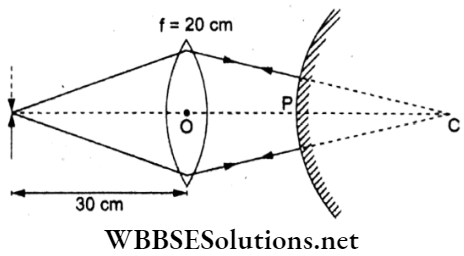
Question 37. A lens is made of flint glass (refractive index = 1.5). When the lens is immersed in a liquid with a refractive index of 1.25, its focal length
- Increases by a factor of 1.25
- Increases by a factor of 2.5
- Increases by a factor of 1.2
- Decreases by a factor of 1.2
Answer: 2. Increases by a factor of 2.5
⇒ \(\frac{1}{f_{\mathrm{a}}}=\left({ }^{\mathrm{a}} \mu_{\mathrm{g}}-1\right)\left(\frac{1}{R_1}-\frac{1}{R_2}\right)\) → (1)
When the lens is immersed in the liquid (μ1 =1.25), the focal length is
⇒ \(\frac{1}{f_1}=\left({ }^1 \mu_{\mathrm{g}}-1\right)\left(\frac{1}{R_1}-\frac{1}{R_2}\right)\) → (2)
Taking the ratio of (1) and (2),
⇒ \(\frac{f_1}{f_{\mathrm{a}}}=\frac{{ }^{\mathrm{a}} \mu_{\mathrm{g}}-1}{\left(\frac{\mu_{\mathrm{g}}}{\mu_1}-1\right)}=\frac{(1.5-1)}{\left(\frac{1.5}{1.25}-1\right)}=\frac{5}{2}\)
⇒ \(f_1=\frac{5}{2} f_{\mathrm{a}}\)
Hence, f increases by a factor of 2.5.
Question 38. A camera lens has an aperture of f and the exposure time is (1/60) s. What will be the exposure time when the aperture becomes 1.4?
- \(\frac{1}{42} \mathrm{~s}\)
- \(\frac{1}{31} \mathrm{~s}\)
- \(\frac{1}{72} \mathrm{~s}\)
- \(\frac{1}{56} \mathrm{~s}\)
Answer: 2. \(\frac{1}{31} \mathrm{~s}\)
The f-number of an optical system. (camera lens) is the ratio of the system’s focal length to the diameter of the aperture (hole) through which light enters. It is the reciprocal of the relative aperture.
Time of exposure (t) ∝ (f-number)2
⇒ \(\frac{t}{(1 / 60) \mathrm{s}}=\frac{(1.4)^2}{1}\)
∴ \(t=(1.4)^2\left(\frac{1}{60}\right) \mathrm{s}=\frac{14 \times 14}{6000} \approx \frac{1}{31} \mathrm{~s}\)
Question 39. A convex lens of refractive index 3/2 has a power of 2.5 D in it is immersed in a liquid of refractive index 2 then the new poof of the lens is
- 1.25 D
- -1.25 D
- -1.5D
- 1.5 D
Answer: 2. -1.25 D
The power of a lens is
⇒ \(P=\frac{1}{f}=(\mu-1)\left(\frac{1}{R_1}-\frac{1}{R_2}\right)\)
When in the air,
⇒ \(2.5 \mathrm{D}=(1.5-1)\left(\frac{1}{R_1}-\frac{1}{R_2}\right)\)
When immersed in the liquid,
⇒ \(P=\frac{1}{f^{\prime}}=\left({ }^{\prime} \mu_{\mathrm{g}}-1\right)\left(\frac{1}{R_1}-\frac{1}{\dot{R}_2}\right)\)
⇒ \(\frac{P}{2.5 \mathrm{D}}=\frac{\left(\frac{\mu_{\mathrm{g}}}{\mu_1}-1\right)}{\left(\mu_{\mathrm{g}}-1\right)}=\frac{\left(\frac{1.5}{2}-1\right)}{(1.5-1)}\)
∴ \(P=-\frac{2.5}{2} \mathrm{D}=-1.25 \mathrm{D}\).
Question 40. In a convex lens of focal length f, the minimum distance between the object and its real image must be
- 3f
- 4f
- 1.5f
- 2f
Answer: 2. 4f
Let D be the separation between the object and its real image formed by a convex lens.
⇒ \(D=|u|+|v|=(\sqrt{u}-\sqrt{v})^2+2 \sqrt{u v}\)
For D to be minimum,
(√u-√v)2 = 0 = u = v.
From the lens formula (for real image),
⇒ \(\frac{1}{v}-\frac{1}{(-u)}=\frac{1}{f}\)
⇒ \(\frac{1}{v}+\frac{1}{v}=\frac{1}{f} \Rightarrow v=u=2 f\)
∴ \((D)_{\min }=2 \sqrt{u v}=2 \sqrt{(2 f)(2 f)}=4 f\)
Question 41. Two identical glass (μg = 1.5) biconvex lenses of focal length f each are kept in contact. The space between the two lenses is filled with water (μw = 4/3). The focal length of the combination is
- \(\frac{f}{3}\)
- f
- \(\frac{4 f}{3}\)
- \(\frac{3 f}{4}\)
Answer: 4. \(\frac{3 f}{4}\)
For a glass convex lens,
⇒ \(\frac{1}{f}=\frac{1}{f_1}=\frac{1}{f_2}=\left(\mu_{\mathrm{g}}-1\right)\left(\frac{1}{R_1}-\frac{1}{R_2}\right)\)
⇒ \(\frac{1}{f}=(1.5-1)\left(\frac{1}{R}-\frac{1}{-R}\right)=\frac{1}{R}\)
For water-biconcave lens,
⇒ \(\frac{1}{f_3}=\left(\mu_w-1\right)\left(\frac{1}{R_1}-\frac{1}{R_2}\right)\)
⇒ \(\left(\frac{4}{3}-1\right)\left(\frac{1}{-R}-\frac{1}{R}\right)\)
⇒ \(\left(\frac{1}{3}\right)\left(-\frac{2}{R}\right)=-\frac{2}{3 R}\)
For an equivalent focal length for the combination,
⇒ \(\frac{1}{F}=\frac{1}{f_1}+\frac{1}{f_2}+\frac{1}{f_3}=\frac{1}{R}+\frac{1}{R}-\frac{2}{3 R}=\frac{4}{3 R}=\frac{4}{3}\left(\frac{1}{f}\right)\)
∴ \(F=\frac{3 f}{4}\)
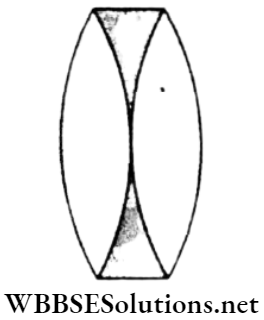
Question 42. Two identical thin plano-convex glass lenses (refractive index = 1.5) each having radius of curvature 20 cm are placed with their convex surfaces in contact at the center. The intervening space between them is filled with oil with a refractive index of 1.7. The focal length of the combination is
- -50 cm
- -25 cm
- 50 cm
- -20 cm
Answer: 1. -50 cm
For the two identical plano-convex lenses of glass,
⇒ \(\frac{1}{f}=\frac{1}{f_1}=\frac{1}{f_2}=\left(\mu_{\mathrm{g}}-1\right)\left(\frac{1}{R_1}-\frac{1}{R_2}\right)\)
⇒ \((1.5-1)\left(\frac{1}{\infty}-\frac{1}{-R}\right)=\frac{1}{2 R}\)
For the biconcave liquid lens,
⇒ \(\frac{1}{f_3}=\left(\mu_l-1\right)\left(\frac{1}{R_1}-\frac{1}{R_2}\right)=(1.7-1)\left(-\frac{1}{R}-\frac{1}{R}\right)=-\frac{1.4}{R}\)
For the equivalent focal length,
⇒ \(\frac{1}{F}=\frac{1}{f_1}+\frac{1}{f_2}+\frac{1}{f_3}=\frac{2}{f_1}+\frac{1}{f_3}=2\left(\frac{1}{2 R}\right)+\left(-\frac{1.4}{R}\right)=-\frac{0.4}{R}\)
∴ \(F=-\frac{R}{0.4}=-\frac{20 \mathrm{~cm}}{0.4}=-50 \mathrm{~cm}\)
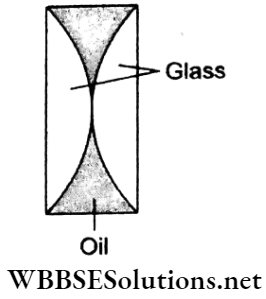
Question 43. A converging beam of rays is incident on a diverging lens. After passing through the lens, the rays converge at a point 15 cm from the lens on the opposite side. If the lens is removed, the point where the rays converge moves 5 cm closer to the lens. The focal length of the lens is
- 5 cm
- -10 cm
- -30 cm
- 20 cm
Answer: 3. -30 cm
In the given figure, rays converge at O without the lens, hence acting as an object. After passing through the concave lens, the rays get slightly diverged and meet at I, which is the position of the image. Thus,
PI = v =15 cm and OP = u =15 cm-5 cm =10 cm.
From the lens formula,
⇒ \(\frac{1}{v}-\frac{1}{u}=\frac{1}{f}\)
⇒ \(\frac{1}{f}=\frac{1}{15 \mathrm{~cm}}-\frac{1}{10 \mathrm{~cm}}=-\frac{1}{30 \mathrm{~cm}}\)
Hence, f = -30 cm.
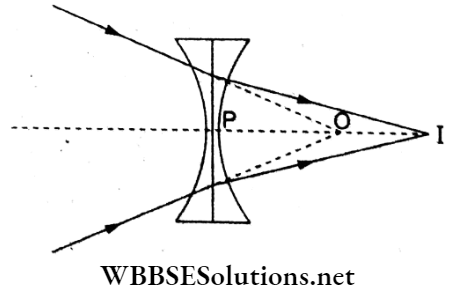
Question 44. Two thin lenses of focal lengths f1 and f2 are in contact and coaxial. The power of the combination is
- \(\frac{f_1+f_2}{2}\)
- \(\frac{f_1+f_2}{f_1 f_2}\)
- \(\sqrt{\frac{f_1}{f_2}}\)
- \(\sqrt{\frac{f_2}{f_1}}\)
Answer: 2. \(\frac{f_1+f_2}{f_1 f_2}\)
For two thin lenses in contact,
⇒ \(\frac{1}{F}=\frac{1}{f_1}+\frac{1}{f_2}=\frac{f_1+f_2}{f_1 f_2}\)
Equivalent power of the combination,
⇒ \(P=\frac{1}{F}=\frac{f_1+f_2}{f_1 f_2}\)
Question 45. A person can see objects clearly only when they lie between 50 cm and 400 cm away from his eyes. In order to increase the maximum distance of distinct vision to infinity, the type and power of the correcting lens the person has to use will be
- Convex, +2.25 dioptre
- Concave, -0.25 dioptre
- Concave, -0.2 dioptre
- Convex, +0.15 dioptre
Answer: 2. Concave, -0.25 dioptre
The person can see distinctly up to 400 cm = 4 m. For distinct vision up to ∞, he needs a concave lens that can form a virtual image at 400 cm when the object is at ∞ as shown in the figure.
From the lens formula,
⇒ \(\frac{1}{v}-\frac{1}{u}=\frac{1}{f}\)
⇒ \(\frac{1}{-400 \mathrm{~cm}}-\frac{1}{\infty}=\frac{1}{f}\)
power of the lens is
∴ \(P=\frac{100}{f_{\mathrm{cm}}} \mathrm{D}=\frac{100}{-400} \mathrm{D}=-\frac{1}{4} \mathrm{D}=-0.25 \mathrm{D}\)
The negative sign is for the concave lens.
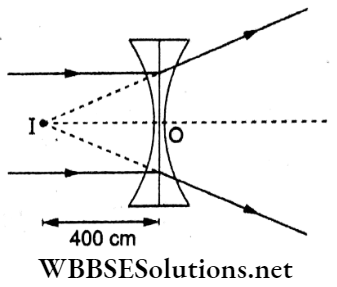
Question 46. For a normal eye, the cornea of the eye provides a converging power of 40 D, and the least converging power of the eye lens behind the cornea is 20 D. Using this information, the distance between the retina and the cornea for the eye lens can be estimated to be
- 5 cm
- 2.5 cm
- 1.67 cm
- 1.5 cm
Answer: 3. 1.67 cm
Given, the converging power of the cornea, PC = +40 D; the least converging power of the eye lens, Pe = +20 D.
equivalent power of eye lens,
P = Pe + PC = 20 D + 40 D = 60 D
But, \(P=\frac{1}{\text { focal length of eye lens }(f)}\)
⇒ \(f=\frac{1}{P}=\frac{1}{60 \mathrm{D}}=\frac{1}{60} \mathrm{~m}=\frac{100}{60} \mathrm{~cm}=\frac{5}{3} \mathrm{~cm}\)
Distance between the retina and cornea for the eye lens
= focal length of the eye lens
∴ \(\frac{5}{3} \mathrm{~cm}=1.67 \mathrm{~cm}\).
Question 47. For a person, the near point of vision is 100 cm. The power the correcting lens requires to provide normal vision is
- +1 D
- -lD
- +3D
- -3D
Answer: 3. +3D
The near point for normal vision is 25 cm.
Hence, the correction lens must be a convex lens as shown in the figure.
The object O placed at 25 cm from the lens forms its virtual image I at 100 cm, which the defective eye can distinctly see.
Thus, \(\frac{1}{f}=\frac{1}{v}-\frac{1}{u}=\frac{1}{(-100 \mathrm{~cm})}-\frac{1}{(-25 \mathrm{~cm})}=\frac{3}{100 \mathrm{~cm}}\)
∴ Power = \(P=\frac{1}{f}=\frac{3}{1 \mathrm{~m}}=+3 \mathrm{D}\)
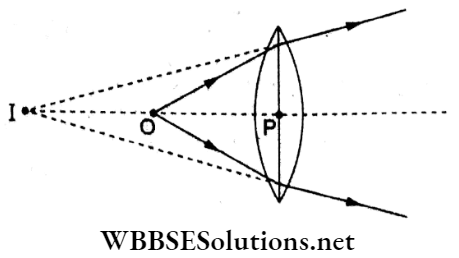
Question 48. A farsighted person has his near point at 50 cm. The power of the lens he should use to see at 25 cm clearly is
- +1D
- +2D
- -2D
- -1D
Answer: 2. +2D
Refer to the ray diagram of the preceding. Here, OP = u = 25 cm and IP = v = 50 cm.
⇒ \(\frac{1}{f}=\frac{1}{v}-\frac{1}{u}=\frac{1}{-50 \mathrm{~cm}}-\frac{1}{-25 \mathrm{~cm}}=\frac{1}{50 \mathrm{~cm}}\)
∴ f = + 50 cm.
So, its power = \(P=\frac{100}{f_{\mathrm{cm}}}=\frac{100}{50} \mathrm{D}=+2 \mathrm{D}\)
Question 49. An astronomical telescope has its objective and eyepiece of focal lengths 40 cm and 4 cm respectively. To view an object 200 cm away from the objective, the lenses must be separated by a distance of
- 46.0 cm
- 50.0 cm
- 54.0 cm
- 37.3 cm
Answer: 3. 54.0 cm
Given, f0 = 40 cm, fe = 4 cm.
Distance of the object AB from objective = u0 = -200 cm.
The image formed by the object is PQ which is formed at the focus of the eyepiece so that the final image is at infinity (for normal adjustment).
Now, \(\frac{1}{v_{\mathrm{o}}}-\frac{1}{u_{\mathrm{o}}}=\frac{1}{f_{\mathrm{o}}}\)
⇒ \(\frac{1}{v_{\mathrm{o}}}=\frac{1}{u_{\mathrm{o}}}+\frac{1}{f_{\mathrm{o}}}=\frac{1}{(-200 \mathrm{~cm})}+\frac{1}{40 \mathrm{~cm}}=\frac{1}{50 \mathrm{~cm}}\)
⇒ v0 = 50 cm.
Hence, the separation between the two lenses,
OQ + QE = 50 cm + 4 cm = 54 cm.
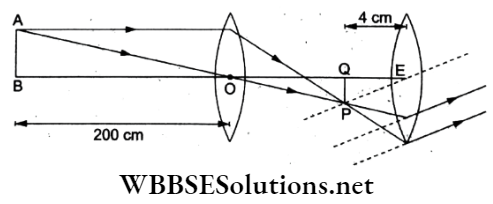
Question 50. In an astronomical telescope in normal adjustment, a straight black line of length L is drawn on the inner part of the objective lens. The eyepiece forms a real image of this line. The length of this line is l. The magnification of the telescope is
- \(\frac{L}{l}+1\)
- \(\frac{L}{l}-1\)
- \(\frac{L+1}{L-1}\)
- \(\frac{L}{l}\)
Answer: 4. \(\frac{L}{l}\)
Magnification produced by the eyepiece is
⇒ \(m_{\mathrm{e}}=\frac{\text { length of image }}{\text { length of object }}=\frac{l}{L}\)
Applying the lens formula,
⇒ \(\frac{1}{v_{\mathrm{e}}}-\frac{1}{\left(-u_{\mathrm{e}}\right)}=\frac{1}{f_{\mathrm{e}}} \Rightarrow \frac{u_{\mathrm{e}}}{v_{\mathrm{e}}}+1=\frac{u_{\mathrm{e}}}{f_{\mathrm{e}}}\)
the telescope is set for a normal adjustment,
\(u_{\mathrm{e}}=f_{\mathrm{o}}+f_{\mathrm{e}}\)⇒ \(\frac{1}{m_{\mathrm{e}}}=\frac{f_{\mathrm{o}}+f_{\mathrm{e}}}{f_{\mathrm{e}}}-1=\frac{f_{\mathrm{o}}}{f_{\mathrm{e}}}\)
⇒ \(m_{\mathrm{e}}=\frac{l}{L}=\frac{f_{\mathrm{e}}}{f_{\mathrm{o}}} \Rightarrow \frac{f_{\mathrm{o}}}{f_{\mathrm{e}}}=\frac{L}{l}\) (1)
But magnification of telescope (in normal adjustment) is \(\frac{f_{\mathrm{o}}}{f_{\mathrm{e}}}=\frac{L}{l}\) [from (1)].
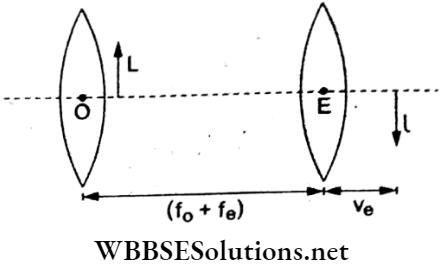
Question 51. If the focal length of the objective lens is increased then the magnifying power(s) of
- A microscope will increase but that of a telescope will decrease
- Both a microscope and a telescope will increase
- Both a microscope and a telescope will decrease
- A microscope will decrease but that of a telescope will increase
Answer: 4. A microscope will decrease but that of a telescope will increase
The magnifying power of a microscope is m = \(\frac{L}{f_{\mathrm{o}}} \frac{D}{f_{\mathrm{e}}}\), thus \(m \propto \frac{1}{f_0}\).
Hence, an increase in f0 will decrease the magnifying power of the microscope.
For a telescope, \(m=\frac{f_{\mathrm{o}}}{f_{\mathrm{e}}}\), hence \(m \propto f_0\).
An increase in f0 will increase the magnifying power of the telescope.
Question 52. The magnifying power of a telescope is 9. When it is adjusted for parallel rays, the distance between the objective and the eyepiece is 20 cm. The focal lengths of the lenses are
- 10 cm and 10 cm
- 15 cm and 5 cm
- 18 cm and 2 cm
- 11 cm and 9 cm
Answer: 3. 18 cm and 2 cm
For a telescope in normal adjustment, tube length = L = f0 + fe = 20 cm
and magnifying power = \(\frac{f_{\mathrm{o}}}{f_{\mathrm{e}}}\) = 9, so f0 = 9fe.
fe + 9fe= 20 cm ⇒ fe = 2 cm
and f0 = 9fe = 9(2 cm) = 18 cm.
Question 53. An astronomical telescope of tenfold angular magnification has a length of 44 cm. The focal length of the objective is
- 440 cm
- 44 cm
- 40 cm
- 4 cm
Answer: 3. 40 cm
Given, angular magnification,
⇒ \(M=\frac{f_{\mathrm{o}}}{f_{\mathrm{e}}}=10 \text {, so } f_{\mathrm{o}}=10 f_{\mathrm{e}}\)
and tube length,
L = f0 + fe = 44 cm
⇒ fe + 10fe = 44 cm ⇒ fe = 4 cm.
A focal length of objective = f0 = 10fe = 40 cm.
Question 54. The astronomical telescope consists of an objective and an eyepiece. The focal length of the objective is
- Shorter than that of the eyepiece
- Greater than that of the eyepiece
- Equal to that of the eyepiece
- Five times shorter than that of the eyepiece
Answer: 2. Greater than that of the eyepiece
In an astronomical telescope the focal length of the objective (f0) is greater than that of the eyepiece (fe), i.e.,f0 > fe.
This produces higher magnification = m = \(\frac{f_0}{f_e}\).
Question 55. A telescope has an objective lens of focal length 200 cm and an eyepiece of focal length 2 cm. If this telescope is used to see a 50-meter-high building at a distance of 2 km, what is the height of the image of the building formed by the objective lens?
- 5 cm
- 10 cm
- 1 cm
- 2 cm
Answer: 1. 5 cm
For the objective lens,
focal length is f0 = 200 cm = 2 m;
object distance is u0= 2 km = 2000 m;
height of the object is h0= 50 m.
From the lens formula,
⇒ \(\frac{1}{v_0}-\frac{1}{\left(-u_0\right)}=\frac{1}{f_0}\)
Multiplying by u0 throughout
⇒ \(\frac{u_0}{v_0}+\frac{u_{\mathrm{o}}}{u_{\mathrm{o}}}=\frac{u_{\mathrm{o}}}{f_0}\)
⇒ \(\frac{1}{m_0}=\frac{u_0}{f_0}-1=\frac{2000 \mathrm{~cm}}{2 \mathrm{~cm}}-1=999\)
⇒ \(m_{\mathrm{o}}=\frac{1}{999}=\frac{h_1}{h_{\mathrm{o}}}=\frac{h_{\mathrm{I}}}{50 \mathrm{~m}}\)
height of the image formed by the objective,
∴ \(h_{\mathrm{I}}=\frac{50 \mathrm{~m}}{999} \approx \frac{50 \mathrm{~m}}{1000}=5 \mathrm{~cm}\).
Question 56. The focal lengths of the objective and the eyepiece of a microscope are 1.6 cm and 2.5 cm respectively. The distance between the two lenses is 21.7 cm. If the final image is formed at infinity, what is the linear magnification?
- 11
- 110
- 1.1
- 44
Answer: 2. 110
Given, that f0 =1.6 cm, fe = 2.5 cm, the distance between the lenses is OE = v0 + fe = 21.7 cm.
Since the final image is formed at infinity, the position of image PQ formed by the objective must be situated at the focus of the eyepiece, so ue = QE = fe = 2.5 cm.
Hence, the image distance for the objective,
v0 = OQ = 21.7 cm- 2.5 cm =19.2 cm.
Now, \(\frac{1}{v_0}-\frac{1}{\left(-u_0\right)}=\frac{1}{f_0}\)
⇒ \(\frac{v_0}{v_0}+\frac{v_0}{u_0}=\frac{v_0}{f_0}\)
So, magnification due to objective,
⇒ \(m_{\mathrm{o}}=\frac{v_{\mathrm{o}}}{u_{\mathrm{o}}}=\frac{v_{\mathrm{o}}}{f_{\mathrm{o}}}-1=\frac{19.2 \mathrm{~cm}}{1.6 \mathrm{~cm}}-1=11\)
The magnification when the final image is formed at infinity is given by
⇒\(m=\frac{v_{\mathrm{o}}}{u_{\mathrm{o}}}\left(\frac{D}{f_{\mathrm{e}}}\right)=11\left(\frac{25 \mathrm{~cm}}{2.5 \mathrm{~cm}}\right)=110\).
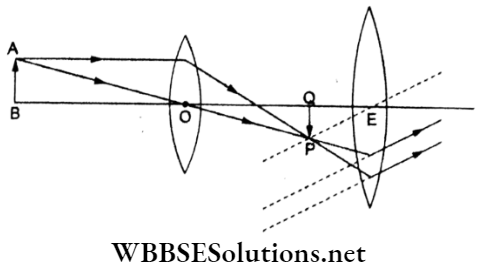
Question 57. The magnifying power of a compound microscope increases a
- The focal length of the objective lens is increased and that of the eye lens is decreased
- The focal length of the eyelets is increased and that of the objective is decreased
- The focal lengths of both the objective and the eyepiece are increased
- The focal lengths of both the objective and the eyepiece are decreased
Answer: 4. The focal lengths of both the objective and the eyepiece are decreased
The magnifying power of a compound microscope is given by
⇒ \(M=\frac{v_{\mathrm{o}}}{u_{\mathrm{o}}}\left(1+\frac{\dot{D}}{f_{\mathrm{e}}}\right)=\frac{L}{f_{\mathrm{o}}}\left(1+\frac{D}{f_{\mathrm{e}}}\right)\)
Thus, M increases when both f0 and fe are decreased.
Question 58. The focal lengths of the objective and the eyepiece of a telescope are 200 cm and 4 cm respectively. What is the length of the telescope for normal adjustment?
- 196 cm
- 204 cm
- 250 cm
- 225 cm
Answer: 2. 204 cm
The tube length or the length of a telescope is given by
L = f0+fe =200 cm + 4 cm = 204 cm.
Question 59. A beam of red, green, and blue lights is incident on a right-angled prism. The material of the prism for the above three lights is 1.39, 1.47, and 1.44 respectively. The prism will
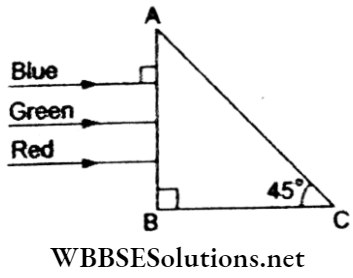
- Separate the blue light from the red and green lights
- Separate all title three lights from one another
- Not separate title three lights at all
- Separate the red light from the green and blue lights
Answer: 4. Separate the red light from the green and blue lights
The refractive index for the given prism when total reflection just occurs is
⇒ \(\mu=\frac{1}{\sin \theta_c}=\frac{1}{\sin 45^{\circ}}=\sqrt{2}\)
The component of the light beam for which μ = 2 will undergo total internal reflection.
Given, μred = 1.39,
μgreen = 1.47 > √2
μblue = 1.44 > √2
Thus, the red light will emerge while the blue and green lights will be totally reflected and separated from the red ones.
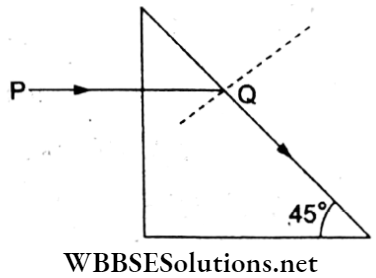
Question 60. Two similar thin biconvex lenses of focal lengths f each are kept coaxially in contact with each other such that the focal length of the combination is F1. When the space between the two lenses is filled with glycerine which has the same refractive index (μ =1.5) as that of glass, the equivalent focal length is F2.. The ratio F1/F2 will be
- 2:1
- 1:2
- 2:3
- 3:1
Answer: 2. 1:2
The focal length of each biconvex lens is given by
⇒ \(\frac{1}{f_1}=(\mu-1)\left(\frac{1}{R}-\frac{1}{-R}\right)=(1.5-1) \frac{2}{R}=\frac{1}{R}\)
For the biconcave lens, the focal length is given by
⇒ \(\frac{1}{f_2}=(\mu-1)\left(\frac{1}{-R}-\frac{1}{+R}\right)=-\frac{1}{R}\)
For combination → (1),
⇒ \(\frac{1}{F_1}=\frac{1}{f_1}+\frac{1}{f_1}=\frac{2}{f_1}=\frac{2}{R}\)
For combination → (2),
⇒ \(\frac{1}{F_2}=\frac{1}{f_1}+\frac{1}{f_2}+\frac{1}{f_1}\)
⇒ \(\frac{2}{f_1}+\frac{1}{f_2}=\frac{2}{R}-\frac{1}{R}=\frac{1}{R}\)
F2 = R
⇒ \(\frac{F_1}{F_2}=\frac{R / 2}{R}=\frac{1}{2}\)
![]()
![]()
Question 61. Pick the incorrect option in the context of a rainbow.
- When the light rays undergo two internal reflections in a water droplet, a secondary rainbow is formed.
- The sequence of colors is reversed in the secondary rainbow.
- An observer can see a rainbow when he is facing the sun.
- A rainbow is a combined effect of refraction and reflection of sun rays.
Answer: 3. An observer can see a rainbow when he is facing the sun.
We cannot see the rainbow while facing the sun. Rainbow is due to refraction, reflection, and dispersion of light from water droplets reaching our eyes from the opposite side.
Question 62. In a total internal reflection when the angle of incidence is equal to the critical angle for the pair of media in contact, what will be the angle of refraction?
- 180°
- 0°
- 90°
- Equal to the angle of incidence
Answer: 3. 90°
The critical angle for a given pair of media is the angle of incidence for which the corresponding angle of refraction is 90°.
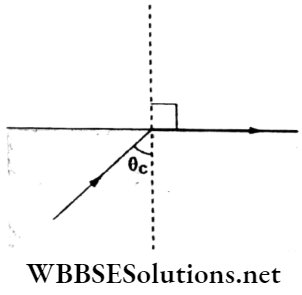
Question 63. A person wears normal glasses of -5 D keeping the distance of glasses from the eyes at 2 cm. If he uses contact lenses then the required power of the lens will be
- +4.5 D
- -5.2 D
- -4.54 D
- +5.2 D
Answer: 3. -4.54 D
The focal length f of the tire concave lens is
⇒ \(\frac{1}{f}=-5 \mathrm{D} \Rightarrow f=-20 \mathrm{~cm}\)
Distance OF = 20cm + 2cm = 22 cm.
With the contact lens, OF = 22 cm, the final image is formed at the retina.
focal length of the contact lens used is fC = OF = -22 cm.
required power,
∴ \(P=-\frac{100}{22} \mathrm{D}=-4.54 \mathrm{D}\)
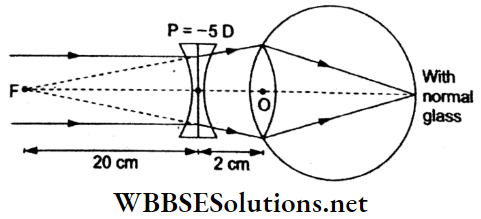
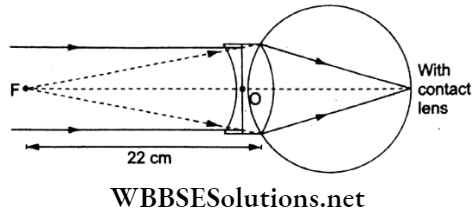
Question 64. How can we change a camera from f/4 to f/5.6?
- By increasing the aperture two times keeping the focal length constant
- By increasing the aperture √2 times keeping the focal length constant
- By reducing the aperture to half keeping the focal length constant
- By reducing the aperture to l/√2 times keeping the focal length constant
Answer: 4. By reducing the aperture to l/√2 times keeping the focal length constant
The f-number of a camera is defined as \(\frac{\text { focal length }}{\text { diameter of aperture }}\)
Thus for an \(\frac{f}{4}\) camera, the F-number is 4, so 4 = \(\frac{f}{D_1}\)
For an \(\frac{f}{5.6}\) camera, the f-number is 5.6, so 5.6 = \(\frac{f}{D_2}\)
Hence, \(\frac{D_2}{D_1}=\frac{4}{5.6}=\frac{1}{1.4}=\frac{1}{\sqrt{2}} \Rightarrow D_2=\frac{D_1}{\sqrt{2}}\).
Question 65. One plano-convex and one plano-concave lens of the same radius of curvature R but of different materials are joined side by side as shown in the figure. The refractive indices of the materials are (μ1 and μ2)and the focal length of the combination is
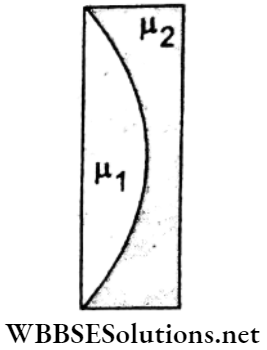
- \(\frac{R}{2-\left(\mu_1-\mu_2\right)}\)
- \(\frac{2 R}{\mu_1-\mu_2}\)
- \(\frac{R}{2\left(\mu_1-\mu_2\right)}\)
- \(\frac{R}{\mu_1-\mu_2}\)
Answer: 4. \(\frac{R}{\mu_1-\mu_2}\)
For a convex lens,
⇒ \(\frac{1}{f_1}=\left(\mu_1-1\right)\left(\frac{1}{\infty}-\frac{1}{-R}\right)=\frac{\left(\mu_1-1\right)}{R}\)
For a concave lens,
⇒ \(\frac{1}{f_2}=\left(\mu_2-1\right)\left(\frac{1}{-R}-\frac{1}{\infty}\right)=-\frac{\left(\mu_2-1\right)}{R}\)
If F is the equivalent focal length of the combination then
⇒ \(\frac{1}{F}=\frac{1}{f_1}+\frac{1}{f_2}=\frac{1}{R}\left(\mu_1-\mu_2\right)\)
∴ \(F=\frac{R}{\mu_1-\mu_2}\).
Question 66. A ray of light AO in a vacuum is incident on a glass slab at 60° and gets refracted at 30° along OB as shown in the figure. The optical path length of light rays from A to B is
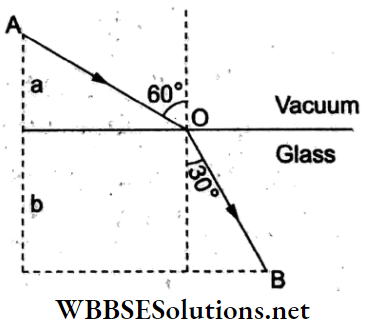
- 2a + 2b
- \(\frac{2 \sqrt{3}}{a}+2 b\)
- \(2 a+\frac{2 b}{3}\)
- \(2 a+\frac{2 b}{\sqrt{3}}\)
Answer: 1. 2a + 2b
⇒ \(\mathrm{AO}+\mu \cdot \mathrm{OB}=\frac{a}{\cos 60^{\circ}}+\left(\frac{\sin 60^{\circ}}{\sin 30^{\circ}}\right) \frac{b}{\cos 30^{\circ}}\)
= 2a + 2b.
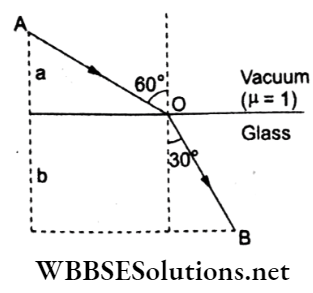
Question 67. An upright object is placed at a distance of 40 cm in front of a converging lens of focal length 20 cm. A converging mirror Of a focal length of 10 cm is placed at a distance of 60 cm on the other side of the lens. The position and size of the final image will be
- 40 cm from the converging mirror, the same size as the object
- 20 cm from the converging mirror, the same size as the size of the object
- 20 cm from the converging mirror, twice the size of the object
- 40 cm from the converging lens, twice the size of the object
Answer: 2. 20 cm from the converging mirror, the same size as the size of the object
The situation is shown in the diagram shown below.
Object PQ is placed at 40 cm from the convex lens which is also equal to 2f(= 2 x 20 cm) of the lens. Thus, a real, inverted image P’Q’ is also formed at 2f(= 40 cm) on the other side of the lens. The distance between P’Q’ and the converging mirror is 20 cm (= 2 x 10 cm) which is the position of its centre of curvature. Hence, a real and inverted image of P’Q’ of the same size will be formed at P’Q’ itself.
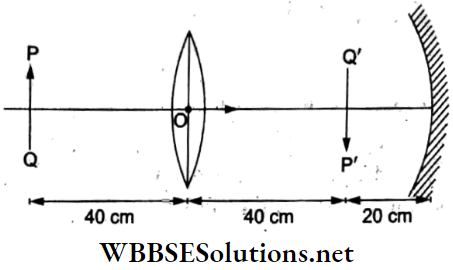
Question 68. A convex lens is placed 10 cm away from a light source and a sharp image is obtained on a screen 10 cm from the lens. Now a glass slab (refractive index = 1.5) of 1.5 cm thickness is placed in contact with the light source. To get the sharp image again, the screen is shifted by a distance d. Then, d is
- Zero
- 1.1 cm away from the lens
- 0.55 cm away from the lens
- 0.55 cm towards the lens
Answer: 3. 0.55 cm away from the lens
For the given convex lens,
⇒ \(|u|=|v|=10 \mathrm{~cm}=2 f \Rightarrow f=5 \mathrm{~cm}\)
When a glass slab (thickness t =1.5 cm, p = 1.5) is placed near the light source, the image of the source undergoes a shift
⇒ \(x=\left(1-\frac{1}{\mu}\right) t=\left(1-\frac{2}{3}\right) \frac{3}{2} \mathrm{~cm}=\frac{1}{2} \mathrm{~cm} \text { towards the lens }\)
Thus, u’ =10 cm-0.5 cm = 9.5 cm.
The corresponding image distance v’ is given by
⇒ \(\frac{1}{v^{\prime}}-\frac{1}{u^{\prime}}=\frac{1}{f}\)
⇒ \(\frac{1}{v^{\prime}}-\frac{1}{(-9.5 \mathrm{~cm})}=\frac{1}{5 \mathrm{~cm}}\)
⇒ \(\frac{1}{v^{\prime}}=\left(\frac{1}{5 \mathrm{~cm}}-\frac{1}{9.5 \mathrm{~cm}}\right) \Rightarrow v^{\prime}=10.55 \mathrm{~cm}\)
Thus, the screen has to be shifted by
(v’-v)- (10.55 cm-10 cm) = 0.55 cm
away from the lens to get a sharp image again
Question 69. A plano-convex lens of refractive index μ1 and focal length f1 is kept in contact with another plano-convex lens of refractive index μ2 and focal length f2. If the radius of curvature of their spherical faces is R each and \(f_1=2\left|f_2\right|\) then μ1 and μ2 are related as
- 3μ2 – 2μ1 = 1
- 2μ2 – μ1 =1
- 2μ1 – μ2 = 1
- μ1 + μ2 = 3
Answer: 3. 2μ1 – μ2 = 1
For a plano-convex lens,
⇒ \(\frac{1}{f_1}=\left(\mu_1-1\right) \frac{1}{R} \text { and } \frac{1}{f_2}=\left(\mu_2-1\right) \frac{1}{R}\)
Since \(f_1=2 f_2 \text {, hence } \frac{\left(\mu_1-1\right)}{R}=\frac{\left(\mu_2-1\right)}{2 R}\)
⇒ 2μ1 – 2 = μ2 -1 ⇒ 2μ1 – μ2 =1.
Question 70. Two plane mirrors M1 and M2 are inclined to each other such that a ray of light incident on mirror M1 and parallel to mirror M2 is reflected from mirror M2 so as to be parallel to mirror M1. The angle between the two mirrors is
- 45°
- 75°
- 30°
- 60°
Answer: 4. 60°
The situation given in the question is shown by the diagram. Since AB is parallel to OC, the three angles are each equal to θ. Similarly, the CD is parallel to OB, and the angles θ are equal. In ΔOBC, 3θ =180°.
The angle between the two mirrors is \(\theta=\frac{180^{\circ}}{3}=60^{\circ}\)
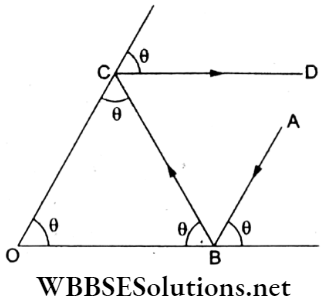
Question 71. The eye can be regarded as a single refracting surface. The radius of curvature of this surface is equal to that of the cornea (7.8 mm). This surface separates two media of refractive indices 1.0 and 1.34. Calculate the distance from the refracting surface at which a parallel of light will come to focus.
- 0.5 cm
- 2.0 cm
- 3.1 cm
- 1 cm
Answer: 3. 3.1 cm
Given, μ1 =1, μ2 = 1.34 and R = +7.8 mm
Parallel rays from infinity converge at I, where PI = v.
For refraction through a spherical surface
⇒ \(\frac{\mu_2}{v}-\frac{\mu_1}{u}=\frac{\mu_2-\mu_1}{R}\)
⇒ \(\frac{1.34}{v}-\frac{1}{\infty}=\frac{1.34-1}{7.8 \mathrm{~mm}}\)
∴ Hence, \(v=\frac{1.34 \times 7.8 \mathrm{~nm}}{0.34}=30.74 \mathrm{~mm} \approx 3.1 \mathrm{~cm}\).
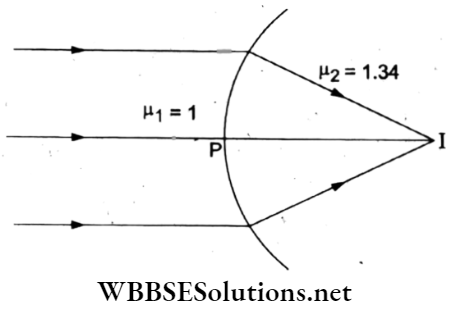
Question 72. A monochromatic light is incident at a certain angle on an equilateral triangular prism and suffers minimum deviation. If the refractive index of the material of the prism is √3, the angle of incidence is
- 45°
- 30°
- 90°
- 60°
Answer: 4. 60°
For a prism,
⇒ \(\mu=\frac{\sin \left(\frac{A+\delta_m}{2}\right)}{\sin \frac{A}{2}}\) → (1)
Given, A = 60°.
For deviation to be minimum, i = i’, r = r’.
But A = 60° = r + r’ = 2r => r = 30°.
And i +i’ = A + δm => 2i = A+ δm . → (2)
Substituting (2) in (1),
⇒ \(\sqrt{3}=\frac{\sin i}{\sin 30^{\circ}}=2 \sin i\)
⇒ \(\sin i=\frac{\sqrt{3}}{2}=\sin 60^{\circ} \Rightarrow i=60^{\circ}\).
Question 73. A point source of light S is placed at a distance L in front of the center of a plane mirror of width d which is hanging vertically on a wall. A man walks in front of the mirror along a line parallel to the mirror at a distance 2L as shown in the figure. The distance over which the man can see the image of the light source in the mirror is
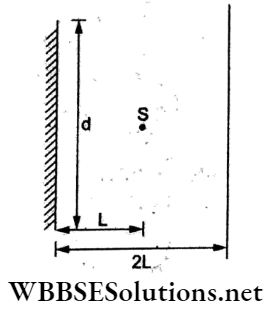
- \(\frac{d}{2}\)
- 2d
- d
- 3d
Answer: 4. 3d
In the given diagram, the distance of light source S from the mirror AB is OS = L = SP ⇒ IP = 3L,
where I is the image of S in the plane mirror.
The observer moving along CD can see the image till the rays reach his eyes at C and D after reflection from the extreme points of the mirror. Thus, from similar triangles IAB and ICD,
∴ \(\frac{\mathrm{AB}}{\mathrm{CD}}=\frac{\mathrm{IO}}{\mathrm{IP}} \Rightarrow \frac{d}{D}=\frac{L}{3 L} \Rightarrow D=3 d\)
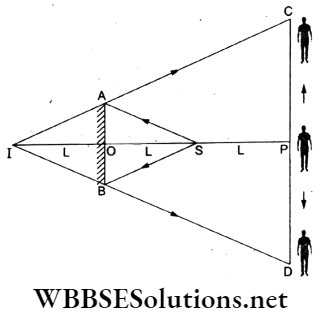
Question 74. The formation of a real image using a biconvex lens is shown in the ray diagram. If the whole set-up is immersed in water without disturbing the object and the screen positions, what will one observe on the screen?
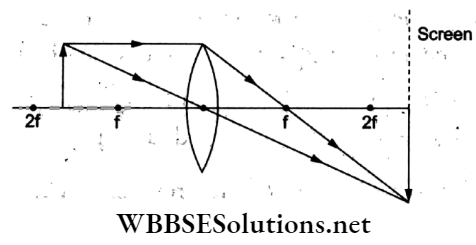
- No change
- Erect and real image
- Magnified image
- Image disappears
Answer: 4. Image disappears
The focal length of a lens depends on the refractive index of the material of the lens as well as on the refractive index of the surrounding medium.
When in the air,
⇒ \(\frac{1}{f_{\mathrm{a}}}=\left({ }^{\mathrm{a}} \mu_{\mathrm{g}}-1\right)\left(\frac{1}{R_1}-\frac{1}{R_2}\right)\)
and when immersed in water,
⇒ \(\frac{1}{f_{\mathrm{w}}}=\left({ }^{\mathrm{w}} \mu_{\mathrm{g}}-1\right)\left(\frac{1}{R_1}-\frac{1}{R_2}\right)=\left(\frac{\mu_{\mathrm{g}}}{\mu_{\mathrm{w}}}-1\right)\left(\frac{1}{R_1}-\frac{1}{R_2}\right)\).
A change in focal length will cause the disappearance of the image from the screen.
Question 75. A ray of light passes through four transparent media with refractive indices μ1, μ2, μ3, and μ4 as shown in the figure. The surfaces of all the media are parallel. If the emergent ray CD is parallel to the incident ray AB, we must have
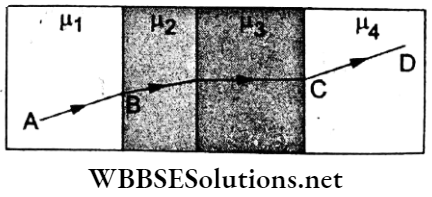
- μ1 = μ2
- μ2 = μ3
- μ3 = μ4
- μ4 = μ1
Answer: 4. μ4 = μ1
According to Snells’ law, the incident and emergent rays through a slab will be parallel provided the media on both sides are identical. This follows for μ4 = μ1
Question 76. A convex lens of focal length 20 cm produces images of the same magnification 2 when an object is placed at two distances x1 and x2 (x1 > x2) from the lens. The ratio of x1 and x2 is
- 4:3
- 3:1
- 5:3
- 2:1
Answer: 2. 3:1
When a real image is formed by a convex lens, v is +ve while u is -ve.
For magnification \(m=2, \frac{|v|}{|u|}=2\)
From the lens formula,
⇒ \(\frac{1}{v}-\frac{1}{u}=\frac{1}{f} \Rightarrow \frac{1}{2 x_1}-\frac{1}{\left(-x_1\right)}=\frac{1}{f}\)
⇒ \(x_1=\frac{3}{2} f\).
When a virtual image is formed, u and v both are negative. Thus,
⇒ \(\frac{1}{v}-\frac{1}{u}=\frac{1}{f} \Rightarrow \frac{1}{\left(-2 x_2\right)}-\frac{1}{\left(-x_2\right)}=\frac{1}{f}\)
⇒ \(x_2=\frac{f}{2}\)
Hence, \(\frac{x_1}{x_2}=3=3: 1\).
Question 77. A thin convex lens L (refractive index A’ 1.5) is placed on a plane mirror M. When a pin is placed at A, such that OA = 18 cm, its real inverted image is formed at A itself as shown in the figure. When a liquid of refractive index μ1 is put in between the lens and the mirror, the pin has to be moved to A’ such that OA’ = 27 cm to get its real inverted image at A’ itself. The value of μ1 will be
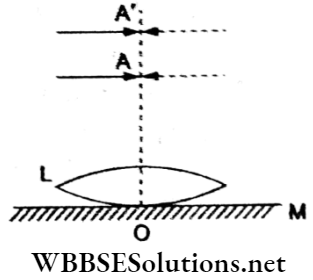
- 3
- 2
- \(\frac{4}{3}\)
- \(\frac{3}{2}\)
Answer: 3. \(\frac{4}{3}\)
When the pin at A coincides with its own image, OA = f, the focal length of the convex lens, for which
⇒ \(\frac{1}{f}=\left(\mu_{\mathrm{g}}-1\right)\left\{\frac{1}{R}-\frac{1}{(-R)}\right\}=(1.5-1)\left(\frac{2}{R}\right)=\frac{1}{R}\)
f = R = OA =18 cm.
When the space between the lens and the plane mirror is filled with a liquid (refractive index \it), the liquid lens will be of focal length flt for which
⇒ \(\frac{1}{f_l}=\left(\mu_l-1\right)\left\{\frac{1}{R}-\frac{1}{\infty}\right\}=\frac{\mu_l-1}{-18 \mathrm{~cm}}\)
For the two lenses in contact, the equivalent focal length, F = OA’ = 27 cm.
⇒ \(\frac{1}{27 \mathrm{~cm}}=\frac{1}{18 \mathrm{~cm}}+\frac{\mu_l-1}{-18 \mathrm{~cm}} \Rightarrow \frac{1}{27}=\frac{1}{18}-\frac{\mu_l-1}{18}\)
⇒ \(\frac{1}{3}=\frac{1}{2}-\frac{\mu_l-1}{2} \Rightarrow \mu_l=\frac{4}{3}\)
∴ \(\mu_l=1+\frac{9}{27}=\frac{4}{3}\).
Question 78. The image of an object placed beyond the center of curvature of a concave mirror will be
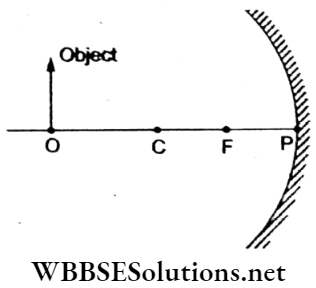
- Virtual, diminished, and inverted
- Virtual, magnified, and inverted
- Reed, magnified and inverted
- Real, diminished, and inverted
Answer: 4. Real, diminished, and inverted
The image of an object placed beyond C of a concave mirror is
- Diminished,
- Inverted,
- Real and
- Lies between C and F, as shown in this ray diagram.
Object: AB.
Image: A’B’.
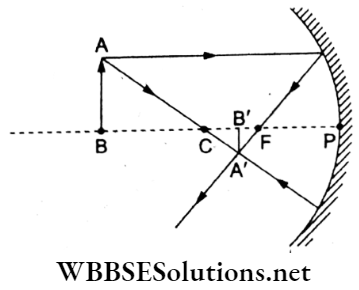
Question 79. A ray is incident at an angle of 60° on the surface of a transparent solid sphere of refractive index √3 at A. At Air Point B, there is partial reflection and emergence as shown. The angle θ between the reflected and emergent rays is
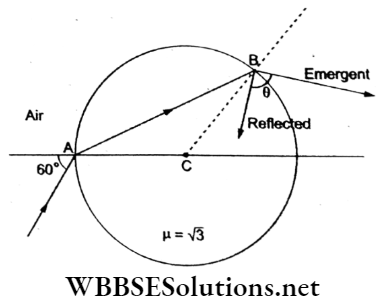
- 60°
- 90°
- 80°
- 70°
Answer: 2. 90°
For refraction at A,
⇒ \(\mu=\frac{\sin i}{\sin r} \Rightarrow \sqrt{3}=\frac{\sin 60^{\circ}}{\sin r}=\frac{\sqrt{3}}{2 \sin r} \Rightarrow r=30^{\circ}\)
So, the angle of emergence ∠NBC = 60°.
The angle of reflection at B is
∠OBD = 30°.
= 180°- (60° + 30°) = 90°.
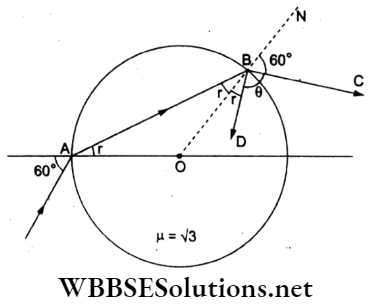
Question 80. A compound microscope forms the final image of an object at 25 cm from the eyepiece. What is the focal length of the eyepiece if the focal length of the objective is 1 cm, the magnification produced is 100 and the tube length is 20 cm?
- 525 cm
- 6.25 cm
- 2.25 cm
- 4.25 cm
Answer: 2. 6.25 cm
For a compound microscope, magnification is
⇒ \(M=\frac{v_{\mathrm{o}}}{u_{\mathrm{o}}}\left(1+\frac{D}{f_{\mathrm{e}}}\right) \approx \frac{L}{f_{\mathrm{o}}}\left(1+\frac{D}{f_{\mathrm{e}}}\right)\)
⇒ \(100=\frac{20 \mathrm{~cm}}{1 \mathrm{~cm}}\left(1+\frac{25 \mathrm{~cm}}{f_{\mathrm{e}}}\right) \Rightarrow 5=1+\frac{25 \mathrm{~cm}}{f_{\mathrm{e}}}\)
⇒ \(f_{\mathrm{e}}=\frac{25 \mathrm{~cm}}{4}=6.25 \mathrm{~cm}\).
Question 81. In the displacement method for measuring the focal length of a convex lens, the distance between the object and the screen is 100 cm. The separation between the two positions of the lens for image formation was 40 cm. Find N, if the power of the lens is 100/N dioptre.
- 15
- 40
- 21
- 25
Answer: 3. 21
Focal length = \(f=\frac{D^2-x^2}{4 D}=\frac{(100 \mathrm{~cm})^2-(40 \mathrm{~cm})^2}{(400 \mathrm{~cm})}=21 \mathrm{~cm}\)
∴ Power: \(P=\frac{100}{f_{\mathrm{cm}}} \mathrm{D}=\frac{100}{N} \mathrm{D} \Rightarrow N=f=21\)
Question 82. An equiconvex lens of radius R has power P. A plano-convex lens with a radius of curvature R’ and made of the same material as power 1.5P. The value of R’ is
- \(\frac{3}{2} R\)
- 2R
- \(\frac{R}{2}\)
- \(\frac{R}{3}\)
Answer: 4. \(\frac{R}{3}\)
For the equiconvex lens,
⇒ \(P=\frac{1}{f}=(\mu-1)\left\{\frac{1}{R}-\frac{1}{(-R)}\right\}=(\mu-1) \frac{2}{R}\)
For the plano-convex lens
⇒ \(P^{\prime}=\frac{3}{2} P=(\mu-1)\left(\frac{1}{R^{\prime}}-\frac{1}{\infty}\right)=\frac{(\mu-1)}{R^{\prime}}\)
∴ \(\frac{3}{2}(\mu-1) \frac{2}{R}=\frac{(\mu-1)}{R^{\prime}} \Rightarrow R^{\prime}=\frac{R}{3}\)

